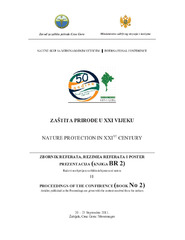| dc.creator | Simonović Radosavljević, Jasna | |
| dc.creator | Mitrović, Aleksandra Lj. | |
| dc.creator | Đikanović, Daniela | |
| dc.creator | Spasojević, Ivan | |
| dc.creator | Mutavdžić, Dragosav | |
| dc.creator | Radotić, Ksenija | |
| dc.creator | Bogdanović Pristov, Jelena | |
| dc.date.accessioned | 2023-12-08T22:14:19Z | |
| dc.date.available | 2023-12-08T22:14:19Z | |
| dc.date.issued | 2011 | |
| dc.identifier.isbn | 2345-324522 | |
| dc.identifier.uri | http://rimsi.imsi.bg.ac.rs/handle/123456789/2939 | |
| dc.description.abstract | Picea omorika ((Pančić) Purkyně) is endemic to the Drina River valley in western Serbia and eastern Bosnia and Herzegovina near Višegrad. It was originally discovered near the village of Zaovine on the Tara Mountain in 1875, and named by the Serbian botanist Josif Pančić. Lignin in cell walls provides a mechanical support as well as a plant protection and resistance from the chemical and biological stress. In coniferous trees, coniferyl alcohol is a basic substrate for lignin production. In this study we analyzed lignin content in the needles of three half-sib P. omorika lines. The needles were obtained from 15-years old Picea omorika trees, grown in a generative seed orchard in Godovik (43°51' N, 20°02' E, 400 m a.s.l.), Serbia. Since there is no absolute reliable method for the determination of lignin content, lignin quantification was performed in three different ways: by acetyl bromide test using: 1) 2 mg of NaOH hydrolyzed cell walls or 2) 1 mg lignin-thioglycolic acid complex (LTGA), as well as 3) by measuring absorbance of LTGA dissolved in 0.5 M NaOH at 280 nm. In acetyl bromide test, standard curves were obtained using freshly prepared solutions of coniferyl alcohol. In procedure (3), a standard curve was obtained with dehydrogenate polymer (DHP) synthesized from coniferyl alcohol.
The determination of lignin quantity in three different ways proved to be reasonable. Acetyl bromide test uses cell wall as a starting material, which is the main reason why lignin content might be overestimated. On the other hand, lignin quantification using thioglycolic acid may underestimate lignin content, since predominantly β-O-4 bonds are observed by this method. There was a significant difference in lignin concentration among all three lines. An acetyl bromide test of both isolated lignin and extract-free cell walls gave the same ratio of lignin concentration among the three lines. Lignin concentration was the highest in B5 line, according to both the acetyl bromide test and the maximum of lignin absorption in NaOH. As lignin make a part of plant antioxidant capacity, the results presented may indicate that among the studied P. omorika lines, B5 may have the highest protective capacity. | sr |
| dc.language.iso | en | sr |
| dc.publisher | Zavod za zaštitu prirode Crne Gore | sr |
| dc.rights | openAccess | sr |
| dc.rights.uri | https://creativecommons.org/licenses/by/4.0/ | |
| dc.source | International conference Nature protection in XXI century | sr |
| dc.subject | cell wall Picea omorika (Pančić) Purkynĕ lignin | sr |
| dc.title | Lignin content in Picea omorika needles | sr |
| dc.type | conferenceObject | sr |
| dc.rights.license | BY | sr |
| dc.citation.epage | 414 | |
| dc.citation.spage | 411 | |
| dc.identifier.fulltext | http://rimsi.imsi.bg.ac.rs/bitstream/id/7631/2.pdf | |
| dc.identifier.rcub | https://hdl.handle.net/21.15107/rcub_rimsi_2939 | |
| dc.type.version | publishedVersion | sr |

